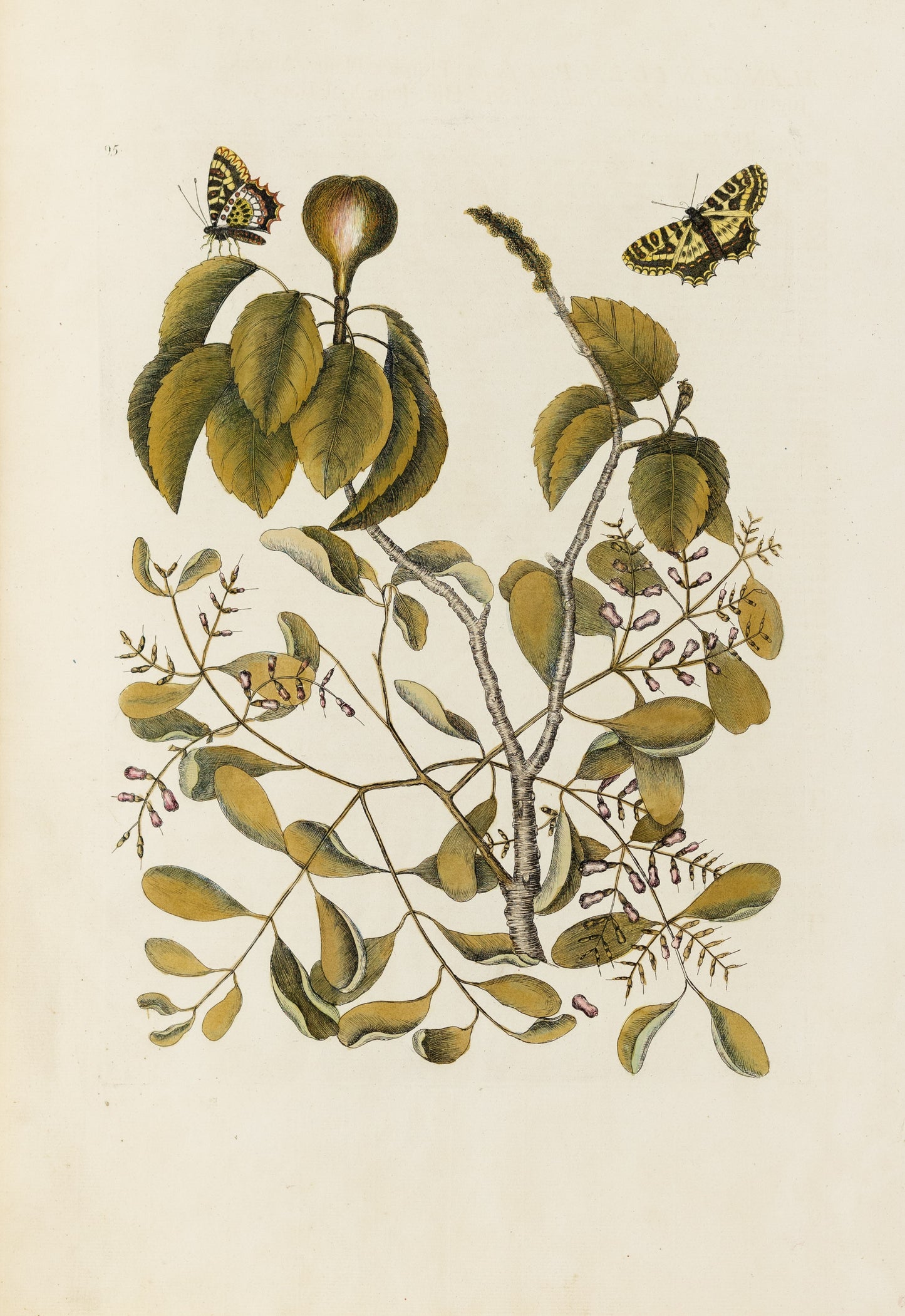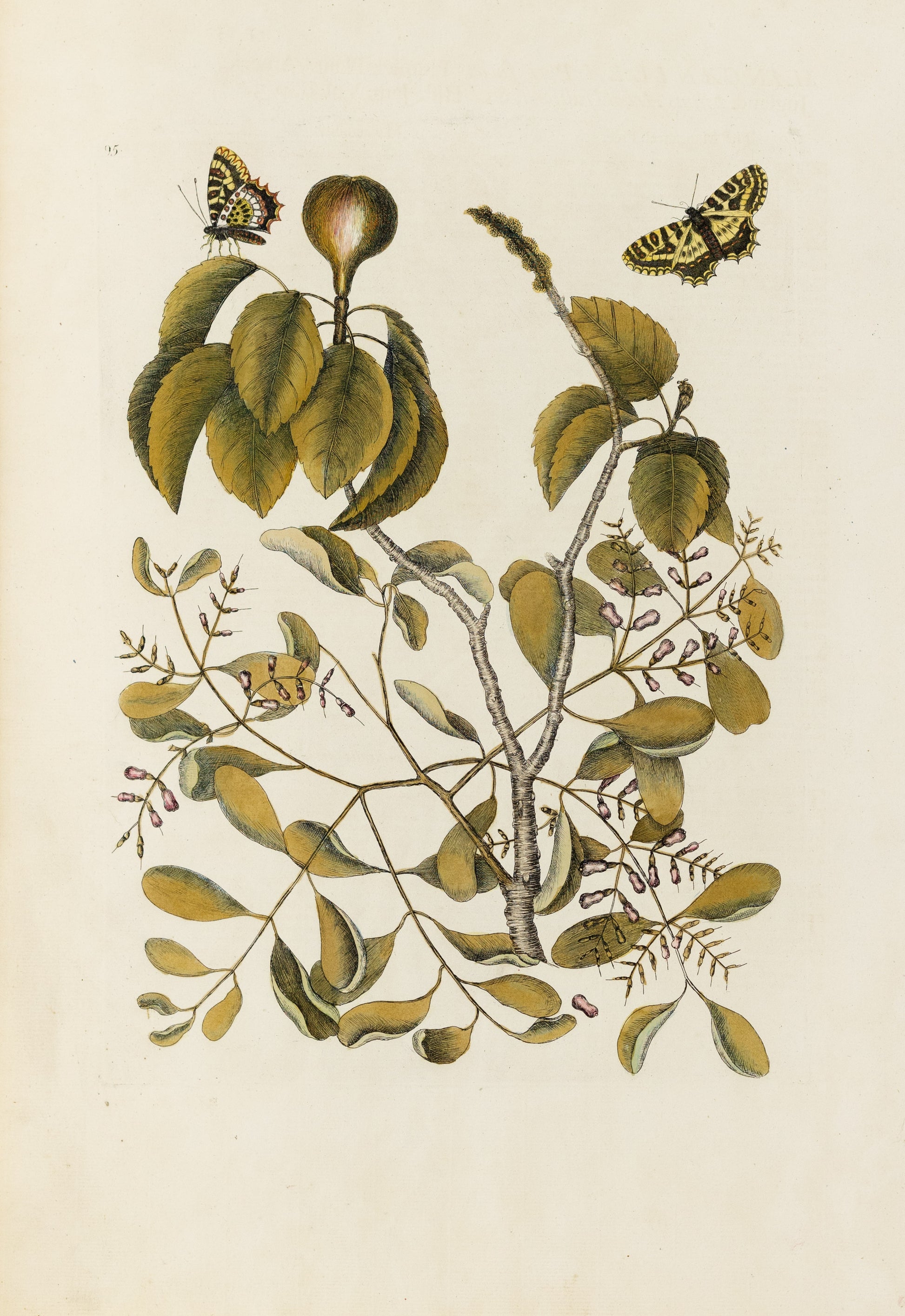Catesby, Mark. Vol.II, Tab. 95, The Mancaneel Tree, Misleto, butterfly
Catesby, Mark. Vol.II, Tab. 95, The Mancaneel Tree, Misleto, butterfly
Couldn't load pickup availability
Mark Catesby (1638 - 1749)
Etching with hand color, paper dimensions: approximately 14 x 19 inches
From Volume II, Part 10 of Catesby's Natural History of Carolina, Florida & the Bahama Islands
London: 1743 - 1771
MANCANILLA Pyri facie: Plumier Plant. Americ. Juglandi affinis Arbor Julisera &c. Hist. Jam. Vol. II. p. 3.
The MANCANEEL-TREE.
These Trees usually grow to a large Size, having a light coloured smooth Bark, under which is contained a white milky Juice, of a very poisonous Nature; the Leaves are smooth, serrated, some- what short, and pointed. The Flowers grow at the Ends of the Branches, consisting of small Tufts of very little yellow pappous Blossoms, placed at Intervals, the Length of about three Inches: The Fruit was the Size of the Figure, growing erect, and shaped like a Pear, or rather a Fig; but not being ripe, or even full grown, I had no Opportunity of seeing its Seeds, which Sir Hans Sloane, in his Nat. Hist. of Jamaica says are several, somewhat resembling those of a Melon, and are contain'd in a roundish very hard Stone, with many sharp Points on each Side of it.
The Wood of this Tree is close grained, very heavy and durable, beautifully shaded with dark, and lighter Streaks, for which it is in great Esteem for Tables and Cabinets, and other curious Works in Joynery; but the virulent and dangerous Properties of these Trees, causes a general Fear, or at least Caution, in felling them; this I was not sufficiently satisfyed of, 'till assisting in the cutting down a Tree of this Kind on Andros Island, I paid for my Incredulity, some of the milky poisonous Juice spurting in my Eyes, I was two Days totally deprived of Sight, and my Eyes, and Face, much swelled, and felt a violent pricking Pain, the first twenty-four Hours, which from that Time abated gradually with the Swelling, and went off without any Application, or Remedy, none in that uninhabited Island being to be had: It is no Wonder that the Sap of this Tree should be so virulent, when Rain or Dew, falling from its Leaves on the naked Flesh, causes Blisters on the Skin, and even the Effluvia of it are so noxious as to affect the Senses of those which stand any Time under its Shade: Other malignant Effects are commonly attributed to it, but t think with little Probability, one Charge of their pernicious Quality is, that Animals which feed on the Fruit, are so infected by it that Death is often the Fate of those that feed on such Animals: this is refuted in the Instance of Guana's feeding on the Apples of Mancaneel without Harm to those who eat these same Guano's, p. 64. Vol. II the Report also that the Baracoudas and other Fish receive their poisonous Quality by feeding on Mancaneel Apples, this is likewise erroneous, there being very few of these trees on those of the Bahama Islands, I was at, and none growing on the Sea-shore, nor within many Miles of those Parts of the Bahama Seas, where these infectious Fish are known to abound; and admitting they were in Plenty, the Nature and Position of the Land admits of no Conveyance by Channels or other-wise into the Sea. Thus it is evident that the Fruit of three Trees will not infect the Flesh of Animals, and supporting they had that Effect, the Quantity of the Fruit, received into the Sea, would not be sufficient to infect the thousandth Part of the Fish that are generally known to be poisonous. As to the real Cause of poison Fish in the Bahama Seas, and elsewhere near the Tropicks, I shall attempt to account for it in another Place. In the mean Time I beg Leave to refer to the above learned Author, who has given farther Particulars relating to this remarkable Tree in his Natural History of Jamaica, Vol. II, p. 4.
VISCUM foliis latioribus; baccis purpureis pediculis incidentibus.
The Leaves of this Misleto grow by Pairs, they are narrow at their Beginning, and broad at their Ends, set on slender pliant Stalks, growing confusedly, after the Manner of the common Mifleto; between every Pair of Leaves shoots forth two slender Stalks of about three Inches long, with Pairs of oblong purple coloured Berries, set opposite to each other.
These Plants I found growing on many of the Mancaneel Trees, but did not observe them on any other Tree.
PAPILIO medius, Gadetanus, ex nigro & sulphureo varius, maculis coccineis notatus.
The upper Part of the Body of this Fly is black, with two Rows of red Spots, below which on each Side are the like Number of white Spots; the upper Sides of the four Wings are variously marked with yellow, brown, and red Spots, which last are all encompassed with brown: The under Part of the Wings are differently marked, tho' with the same Colours, except that the two lower Wings have a large Portion of white.
Mark Catesby (1683 – 1749)
Facts regarding Catesby’s early years are scant. It is known that he was born in the ancient market town of Sudbury, England to a father who was a legal practitioner and mayor of Sudbury and to a mother from an old Essex family. It seems that he received an understanding of Latin and French and was familiar with the eminent naturalist Reverend John Ray. Following his father’s death, he was endowed with the means to pursue his interest in the natural history of North America.
Catesby arrived in Virginia in 1712 as the guest of his sister and her husband, Dr. William Cocke, an aid the Governor of the colony. Soon he was acquainted with the well-connected William Byrd, a Fellow of the Royal Society whose diary contains passages discussing Catesby’s strong curiosity with all things relating to North America.
This included plants native to the fields and woods of Virginia through which Catesby traveled, collecting examples of botanical specimens unfamiliar in England, which he illustrated and sent back to his uncle, Nicholas Jekyll and the apothecary and botanist, Samuel Dale.
Catesby’s first trip to the New World was extensive and included a visit to Jamaica. Although he felt that his approach to a larger understanding of its natural history was lacking in structure, his experience would inform his future expeditions.
Following his return to London in 1719 Catesby resolved to return to the colonies and gather additional information for his illustrated Natural History... He gained the financial support of members of the local scientific community, many of who were members of the Royal Society keen to send a naturalist to Carolina who could provide an accurate account of its resources. Among those who belonged to the Royal Society was William Sherard, who after examining Catesby’s drawings, was key in advancing the project. With further backing by Sir Hans Sloane, court physician and naturalist whose collection would form the basis for The British Museum, Catesby sailed to Carolina in 1722.
Catesby’s four years of travels following his second arrival in North America brought him throughout South Carolina, parts of Georgia, and the Bahamas. He was
intent on visiting the same location at different times throughout the year in order to observe his subjects as they developed. In addition to gathering botanical specimens of potential horticultural importance, he also acquired birds and other creatures.
Catesby’s patrons in London were eager to receive examples of the varieties of plants and animals he encountered but collecting, packaging, and sending them back to England served as a distraction to his intended Natural History... Nevertheless, he continued to observe, paint, and write descriptions of the previously un-investigated wildlife he encountered on the shores and in the swamps, woods, and fields of the middle American colonies.
Catesby returned to England from his final voyage to America in 1726 and spent the next seventeen years preparing his Natural History... He envisioned his work containing colored plates reproducing his studies from nature in a substantial, folio-sized format, an achievement nearly unprecedented in earlier natural history publications. Catesby arranged for financing in the form of an interest-free loan from the Quaker Peter Collinson, a fellow of the Royal Society. Nevertheless, the cost of paying professionals to prepare his delineations on copper plates for printing was too great. To this end, with the assistance of Joseph Goupy (1689–1769), a French artist living in London, he taught himself to etch. In addition to producing nearly all of the plates for his publication, Catesby closely supervised the coloring of the engravings, either painting the impressions himself or closely overseeing the work to insure its fidelity to his preparatory work. To further finance the project Catesby sold subscriptions, offering his book in sections of 20 plates to be published every four months.
The first volume of Natural History of Carolina, Florida & the Bahama Islands, containing one hundred plates, was completed in 1731 and no doubt facilitated his election as a fellow of the Royal Society in February, 1733. The second volume, also containing one hundred plates, was finished in 1743 and was supplemented with twenty plates based on information sent to Catesby by John Bartram and others in in America appeared in 1746–1747. Of the approximately 180 - 200 copies of the first edition produced, roughly 80 copies remain complete and accounted for and there are an unknown number in private collections. A second edition was issued by George Edwards in 1754 and a third edition, published by Benjamin White, in 1771 who continued to print examples of the plates until at least 1816. As early as 1749 editions were produced for the European market with translations of the text in German, Latin, and Dutch. In these the plates for the first volume and appendix were re-etched by Johann Michael Seligmann and the plates for the second volume re-etched by Nicolaus Friedrich Eisenberger and Georg Lichtensteger.
Catesby’s tenacity resulted in a sweeping and compelling study of American plants, animals, and marine life native to little documented lands in which he strove to assign scientific nomenclature to his subjects. Indeed, Linnaeus, in his 1758 Systema Naturae, made use of much information brought to light by Catesby using it as the foundation of his system of binomial nomenclature for American species.
Throughout the production of his Natural History…Catesby lived in London with his Elizabeth Rowland with whom he had four children and married in 1747, before his death in 1749.


